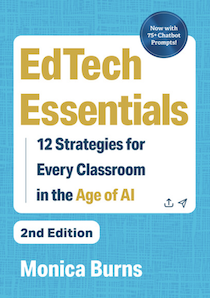Essential AI Strategies for Every Classroom
EdTech Essentials: 12 Strategies for Every Classroom in the Age of AI
By Monica Burns
(ASCD, 2024 – Learn more)
Reviewed by Stacy Haynes-Moore

Perhaps you noticed a shift in your uses of technologies during the last several years – particularly if teaching during pandemic months? I co-taught 6th graders online. It was not easy to move from a physical space to then coordinate, learn, and adapt tech for existing curriculum, and it was not without moments of wanting to chuck Chromebooks. Online teaching did, though, enhance my work and help me see new ways of instructing and communicating with students.
For me, that experience – only a short time ago, really – also represents a larger cultural turn for K-12 schooling. Technologies are ever-present in teaching and learning and continue to influence classroom practices. Recent reports indicate an increased exploration of ed tech nationwide in schools – and this includes the use of chatbots and other forms of artificial intelligence.
Using AI to generate wide ranging content

However, the emergence of generative AI now provides access and means to generate content that includes images, videos, music, and text.
Burns argues that students’ understanding of AI and its influences varies widely and needs to be bolstered. “If we truly believe the role of education in society is to prepare all children for success beyond the classroom, students must participate in meaningful, robust EdTech experiences,” she writes.
Burns’ knowledge of ISTE standards helps her guide her reading audience, and she provides many concrete examples of ed tech and AI embedded within purposeful instruction. The book’s 12 chapters, three appendices, and bonus resources (provided to readers via QR codes) are approachable no matter the comfort level an educator may have with AI or digital technologies.
Strategies and the activities to bring them alive
Burns titles the chapters with strategies such as Navigate Online Spaces Effectively, Assess to Check for Understanding, and Plan for Tech-Rich Learning Experiences. Each strategy centers the importance of classroom learning tasks (the goals) rather than focusing on a specific type of classroom technology (a means).
Several entry points for teachers (or teaching teams) throughout the book could be useful as we consider and discuss implementations of new technologies, model their uses, or identify guiding principles for teachers’ decisions as they select and apply the tech.
What I found most valuable about reading EdTech Essentials are the activities provided in each chapter. QR codes, model prompts, and lists of tech tools lead the reader to explore and practice. It’s likely that readers will find themselves experimenting with chatbots, refining their use of language prompts, remixing or creating graphics, etc. to better understand the mechanisms of generative AI and proactively step into the experience as a critically-thinking consumer, creator, and educator.
Dr. Stacy Haynes-Moore is a veteran classroom teacher for K-12 schools and has served district colleagues in various leadership roles, including that of instructional coach and curriculum facilitator for grades 6-12 English Language Arts. She currently carries forward her passion for teaching, learning, and leading as Assistant Professor in Education at Coe College.




























